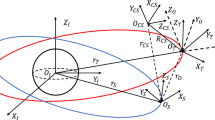Abstract
This paper presents a novel multicopter design with an additional momentum wheel. The added angular momentum reduces the vehicle’s sensitivity to torque disturbances compared to a conventional multicopter. The mechanical design, coupled with intelligent feedback control, allows for operation of autonomous aerial systems in challenging environments where conventional designs may fail. Sensitivity to torque disturbances is shown to monotonically decrease with increasing angular momentum, and the effect scales such that a greater improvement in torque disturbance sensitivity is experienced by smaller vehicles. For a fixed vehicle size, a trade-off exists between the added torque disturbance rejection capability, the power required to carry the wheel’s added mass, and the kinetic energy of the rotating wheel. A cascaded controller structure is proposed that accounts for the additional angular momentum and that accelerates or decelerates the momentum wheel to gain additional control authority in yaw. Theoretical results are validated experimentally using two vehicles of different scales. The proposed vehicle design is likely to be of value in situations where precision control is required in the face of large disturbances.










Similar content being viewed by others
References
Anderson, B., Moore, J.: Optimal Control: Linear Quadratic Methods. Prentice-Hall International, Upper Saddle River (1989)
Besnard, L., Shtessel, Y.B., Landrum, B.: Quadrotor vehicle control via sliding mode controller driven by sliding mode disturbance observer. J. Frank. Inst. 349(2), 658–684 (2012)
Bryson, A., Ho, Y.C.: Applied Optimal Control: Optimization, Estimation and Control. CRC Press, Boca Raton (1975)
Bucki, N., Mueller, M.W.: Improved quadcopter disturbance rejection using added angular momentum. In: IEEE/RSJ International Conference on Intelligent Robots and Systems (IROS), pp. 4164–4170. IEEE (2018)
Cabecinhas, D., Cunha, R., Silvestre, C.: A nonlinear quadrotor trajectory tracking controller with disturbance rejection. Control Eng. Pract. 26, 1–10 (2014)
Driessens, S., Pounds, P.: The triangular quadrotor: a more efficient quadrotor configuration. IEEE Trans. Robot. 31(6), 1517–1526 (2015)
Green, M., Limebeer, D.: Linear Robust Control. Dover Publications, Mineola (1995)
Kushleyev, A., Mellinger, D., Powers, C., Kumar, V.: Towards a swarm of agile micro quadrotors. Auton. Robots 35(4), 287–300 (2013)
Likins, P.W.: Attitude stability criteria for dual spin spacecraft. J. Spacecr. Rockets 4(12), 1638–1643 (1967)
McCormick, B.W.: Aerodynamics Aeronautics and Flight Mechanics. Wiley, New York (1995)
Mingori, D.: Effects of energy dissipation on the attitude stability of dual-spin satellites. AIAA J. 7(1), 20–27 (1969)
Mueller, M.W.: Multicopter attitude control for recovery from large disturbances (2018). arXiv:1802.09143
Mueller, M.W., D’Andrea, R.: Stability and control of a quadrocopter despite the complete loss of one, two, or three propellers. In: IEEE International Conference on Robotics and Automation (ICRA), pp. 45–52. IEEE (2014)
Mueller, M.W., D’Andrea, R.: Relaxed hover solutions for multicopters: Application to algorithmic redundancy and novel vehicles. Int. J. Robot. Res. 35(8), 873–889 (2016)
Piccoli, M., Yim, M.: Passive stability of a single actuator micro aerial vehicle. In: IEEE International Conference on Robotics and Automation (ICRA), pp. 5510–5515. IEEE (2014)
Piccoli, M., Yim, M.: Passive stability of vehicles without angular momentum including quadrotors and ornithopters. In: IEEE International Conference on Robotics and Automation (ICRA), pp. 1716–1721. IEEE (2015)
Pounds, P., Mahony, R., Hynes, P., Roberts, J.M.: Design of a four-rotor aerial robot. In: Australasian Conference on Robotics and Automation (ACRA), pp. 145–150. Australian Robotics & Automation Association (2002)
Ryll, M., Bülthoff, H.H., Giordano, P.R.: First flight tests for a quadrotor UAV with tilting propellers. In: IEEE International Conference on Robotics and Automation (ICRA), pp. 295–302. IEEE (2013)
Wallace, D.A.: Dynamics and control of a quadrotor with active geometric morphing. Master’s thesis (2016)
Waslander, S., Wang, C.: Wind disturbance estimation and rejection for quadrotor position control. In: AIAA Infotech@Aerospace Conference (2009)
Zhang, R., Quan, Q., Cai, K.Y.: Attitude control of a quadrotor aircraft subject to a class of time-varying disturbances. IET Control Theory Appl. 5(9), 1140–1146 (2011)
Zhang, W., Mueller, M.W., D’Andrea, R.: A controllable flying vehicle with a single moving part. In: IEEE International Conference on Robotics and Automation (ICRA), pp. 3275–3281. IEEE (2016)
Zipfel, P.H.: Modeling and Simulation of Aerospace Vehicle Dynamics, 2nd edn. American Institute of Aeronautics and Astronautics, New York (2007)
Acknowledgements
This material is based upon work supported by the National Science Foundation Graduate Research Fellowship under Grant No. DGE 1752814 and the Powley Fund.
Author information
Authors and Affiliations
Corresponding author
Additional information
Publisher's Note
Springer Nature remains neutral with regard to jurisdictional claims in published maps and institutional affiliations.
Electronic supplementary material
Below is the link to the electronic supplementary material.
Supplementary material 1 (mp4 62385 KB)
Rights and permissions
About this article
Cite this article
Bucki, N., Mueller, M.W. A novel multicopter with improved torque disturbance rejection through added angular momentum. Int J Intell Robot Appl 3, 131–143 (2019). https://doi.org/10.1007/s41315-019-00093-4
Received:
Accepted:
Published:
Issue Date:
DOI: https://doi.org/10.1007/s41315-019-00093-4




